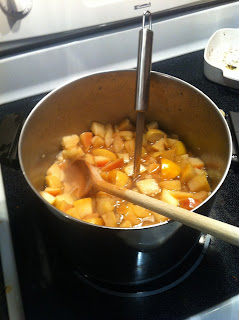At this point... We didn't know what we were getting ourselves into. I'm warning you; this is a long, tedious process. I would HIGHLY recommend just using a juicer or apple press to extract the juice from the fruit.
However, if you wanted to really get hands on and literally, hand squeeze your own apple cider, here's how we did it!:)
To make one gallon of cider, you need:
-glass, gallon-size jug (we used a jug of Carlo Rossi that we
-18-20 pounds of apples (we used golden delicious and jonagold)
-apple slicer
-large stock pot
-whole cinnamon sticks
-whole cloves
-cheese cloth or a sanitized, thin undershirt
-potato masher
First things first, we dumped out most of the Carlo Rossi, rinsed the jug and put it in the dishwasher by itself to get sanitized.
 |
| ...it wasn't very good. I mean, $10 for a gallon of wine, go figure! |
In the meanwhile, we started to chop up all the apples. We rinsed them, chopped them with the apple chopper then sliced them into smaller pieces. We filled the pot with a few inches of water and let that come to a boil BEFORE we tossed all the chopped up apples in.
(For the size of pot we had on hand, we opted to cook the apples in two batches so the image above only shows HALF of what we made).
After letting the apples soften up (about a half hour of cooking on medium), we tried a few different ways of preparing the apples for extracting the juice.
1. A grinding apple sauce maker.
2. Another grinding apple sauce maker.
3. Just MASHING them.
I don't have a picture of this but when we cooked our second batch of apples, we used a potato smasher (like to make mashed potatoes with) and smashed them into a very thin apple sauce. I actually liked this method best for what we were doing.
We then used cheese cloth and a sanitized under shirt to manually SQUEEZE the juice out of the apple sauce. We would scoop about a cup or two into the middle of a folded piece of cheese cloth or shirt and would wrap the apple sauce and carefully squeeze, trying to avoid putting too much pressure: this caused more pulp to get through than we wanted.
This took a while... BUT we wound up with quite a bit of juice!
We heated the apple cider to 160 degrees F to pasteurize it then carefully poured it into the Carlo Rossi jug. (You could also add the cinnamon and cloves at this point too, we did, then strained them out).
You COULD stop here. You have perfect good, home made apple cider to enjoy!
 |
| TA-DA! One gallon of home made cider:) |
However, we pressed on and wanted to ferment our creation! I left this part up to my bf since he is more experienced in homebrewing/ home fermenting.
***My understanding of this process is that the yeast eat the sugar in the juice and then produce alcohol and carbon dioxide. The bubbler on top has water in it so the CO2 can get out but no germies can get in! As long as we keep the cider warm enough, the yeast will keep eating the sugar and producing alcohol until the alcohol level gets too high and kills them.***
We, first, had to wait until the juice had cooled to between 100 and 120 degrees (any hotter and it would kill the yeast). Once it had, he added 1/5 of the packet of champagne yeast to the jug. He promptly sealed the jug with the special fermenting cork with a water bubbler on top.
This is what our final product looked like. We also did another batch using store bought cider.
We set up an area in his house with a heater by them to keep them at 100 degrees. We hope they will be decently fermented in about two weeks, but might wait as long as a month if the yeast still seem to be producing CO2 bubbles.
Here's to hoping this cider turns out wonderfully! Let me know if you've ever embarked on a project that ended up being as difficult and time consuming as this! (This took Friday evening, Saturday evening and Sunday morning!!!).
-S




No comments:
Post a Comment